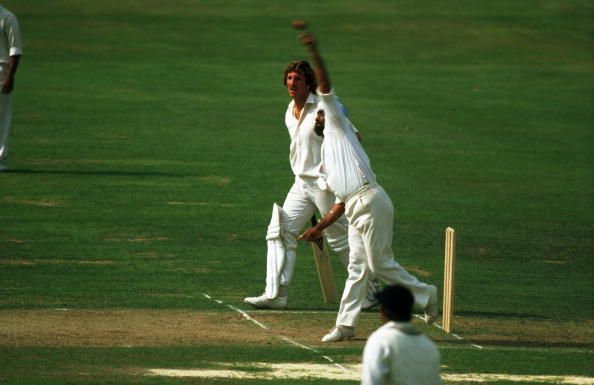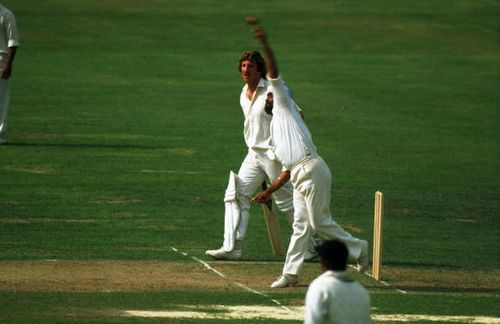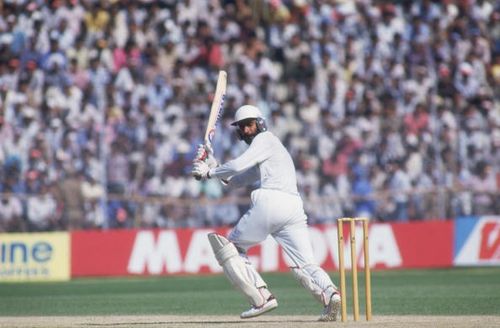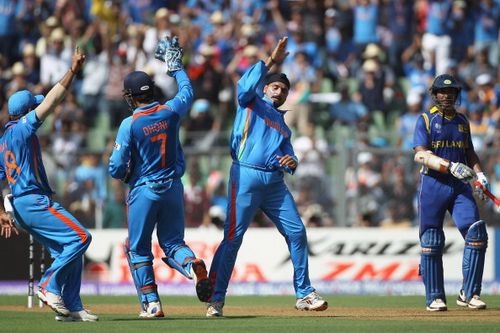
The Rise of the Turbanators
In a century of Indian cricket, there have been more than a few individuals who took to the field wearing the ‘pagri’, the headgear that symbolizes not just a religion, but also qualities of honour, courage and austerity. History called their ancestors ‘saint-soldiers’: people who live for love and die by it.
Here’s a look at three of ‘em Sardars, each of whom rose to prominence at three different points in the history of the game. Separated by generations, each brought to the field his own brand of cricket an invariably larger than life persona and unique fuel-injection mechanisms.
Bishan Singh Bedi: Up, close and extremely personal

7 Aug 1979: Ian Botham of England prepares to run as Bishan Singh Bedi of India bowls during the Second Test match at Lord’s in London.The match ended in a draw.
The 60s was a mixed bag for India. The Green Revolution filled a whole lot of bellies, China spanked our rear for messing with it, a legendary Prime Minister died, only to make way for another, and a doomed romance between a prince and a courtesan set silver screens and box-offices on fire. Indian cricket though, was only headed in one direction – up, thanks to what came to be known as ‘The Indian Spin Quartet’ viz. Eravalli Prasanna, Srinivas Venkataraghavan, Bhagwat Chandrasekhar and Bishen Singh Bedi.
That last guy literally waltzed down the track and spun massacres on the field. Bedi’s left-arm orthodox bowling was a chef-d’oeuvre of equal parts of perfection and deception. There was flight, that femme fatale who seduced batsmen to smash their way all over the park, there was pace, there was loop and plenty of spin. The action was all grace and ease. The latter quality enabled him to bowl on for the entire day without fatigue or loss of rhythm.
Suresh Menon, who authored his biography ‘Bishan: Portrait of a Cricketer’ writes: “Few understood better than Bedi the separate roles played by the fingers, the palm, the arm, the shoulder, the hip, the legs and the toes. He could alter the position of one of them at the top of the bowling mark and change the delivery.”
The result: the sight of him in his iconic ‘patka’ invariably got the guy holding the bat to rethink everything he knew about batting. Bedi’s adaptability to any given track and his sheer guile made a mess of any strategy the batsman might have cooked up.
In many ways, he spearheaded the coming-of-age of Indian cricket. For the first time in its history, India began to return victorious from overseas tours in Australia, West Indies and England. He wasn’t the best skipper India ever had, he led the team to six Test victories in 22 games, but he did make a mockery of the heavy-duty Australian batting line-up during the notorious 1969-70 series. England in 1972 and West Indies in ’76 were other personal conquests. The Sardar’s clout grew, and so did international wariness about the Indian cricket team.
The boy who started playing cricket in the by-lanes of Amritsar at age 13 hung up his dancing shoes twenty years later, after an gruelling five-dayer at the Oval.
By then, the numbers stacked against him were fantastic. In 67 Tests, he took 266 wickets with over a dozen five-wicket hauls. His stint with Northamptonshire is the stuff epics are made off- a cool 1,560 wickets in 370 matches.
On the field, Bedi had generated controversies pertaining to West Indian intimidatory bowling tactics and the infamous John Lever ‘Vaseline’ incident in ’76. Once off the field, though, he reveled in it. Sucker-punching everyone from Muttiah Muralitharan (“if Murali doesn’t chuck, then show me how to bowl“) to Sunil Gavaskar (“a destructive influence“), the subtle artistry gave way to vehement indictments. Not many are aware that he was among the Panel of Selectors who picked the ’83 World Cup winning side, but it is universally known how he humiliated erstwhile Australian coach John Buchanan at the 2003 Wisden International Awards by asking him,” “Tell us, John, have you made this Australian team great, or have they made you?”
Rebellious, larger than life and a storehouse of infinite wisdom, Bishan Singh Bedi is a man you wouldn’t want to mess with- off the field, or on it.
Navjot Singh Sidhu: ‘Nobody travels on the road to success without a puncture or two’

Navjot Sidhu batting for India during a Cricket World Cup first round match against Australia in Delhi, 22nd October 1987. India won the match by 56 runs.
Before running his mouth as incessantly as an inverter in Tamil Nadu, emitting clever-sounding noises (“A fifty is like kissing a virgin, you just have to go on!”) on live TV, and attaining mini-stardom on the small screen, and successfully contesting elections, and being convicted of manslaughter and road-rage, Navjot Singh Sidhu was an opening batsman, as enigmatic and unpredictable as they come.
His made his international debut at Ahmedabad, against a touring West Indies side. It was like a much-hyped film bombing spectacularly upon release, and he was banished to the wilderness for the next couple of years. He did receive a mention in the Indian Express, where a noted cricket columnist wrote an article titled ‘Sidhu: The Strokeless Wonder’. But like they say, you cannot keep a legend in the shadows for long. 1987 was the year Meerut was engulfed in communal inferno, and Gavaskar did his little jig after scoring 10 grand, but also the year Sidhu returned fuming like Mt. Vesuvius on steroids. Four consecutive half-centuries, each involving a plethora of aerial hits, made it seem as though he had made up his mind to win the Cricket World Cup single-handedly for his country.
The same columnist wrote another article; this time titled ‘Sidhu: From Strokeless Wonder to a Palm-Grove Hitter’.
In the early 90s, this Sardar was indispensable. He justified his place in the team by consistently scoring over 500 Test runs annually for the next five years. His batting style was designed to perplex; at times he would be the hermit- the batsman with soft hands and an iron-defense. Then he would suddenly switch contours and unleash the deranged rockstar- deliveries spinning in would invariably disappear into Zion or tear through all around the place. The pure disdain with which he treated spinners was evident in his knock of 124* against Sri Lanka (yeah, Muralitharan and Co. a.k.a. “spin wizards” and all that) which consisted of eight sixes, most of them against the top-dog himself. Shane Warne found himself at the wrong end of Sidhu’s psychopathic blade back in ’97, in a series in which he smashed four fifties in five innings. The same year, he’d conjured up a solid double-hundred, his first in Tests, batting for eleven hours against a vicious West Indian bowling attack.
Every fairy tale has an ending, this one crash-landed on earth like that dinosaur-genocide meteorite. Mohammed Azharuddin was a naughty boy even before he came out as the Dirty One. Apparently he had this habit of swearing unabashedly at our hero at every opportunity he got. From where Sidhu came from, throwing that kind of stuff around in public could get you killed, but Azhar did so in “affection”, as apparently unloading on someone’s father is “a common naughty address to a dear one in Hyderabadi”.
Sidhu didn’t get it that time (rumour has it he still hasn’t . He staged a dramatic ‘walk-out’, taking the next flight home smack in the middle of a high-profile tour of England. There was a probe, and Mohinder Amarnath mollycoddled him back onto the field.
Sidhu announced his retirement from all forms of the game in ’99, to start playing new ones, of course. The 18-year career had earned him 7000 international runs in 50 Tests and well over 100 One-dayers. 27 centuries to boast of, but it didn’t end there. For Sherry, it was only a new beginning.
Harbhajan Singh: “Making it Large”

MUMBAI, INDIA – APRIL 02: Harbhajan Singh (C) of India celebrates with his captain MS Dhoni (2L) after bowling Tillakaratne Dilshan as Kumar Sangakkara (R) of Sri Lanka looks on during the 2011 ICC World Cup Final between India and Sri Lanka at Wankhede Stadium on April 2, 2011 in Mumbai, India.
Bhajji, I mean…Padma Shri Harbhajan Singh Plaha is India’s most successful off-spin bowler. If there is a movie made on his life (buying the rights would be undoubtedly fruitful), it would probably be named ‘Australia and Australia: The Rise and Fall of Harbhajan Singh (Respectively)’.
He has had a very colourful career, to say the least. After an explosive stint in domestic cricket since the age of 15, Bhajji had a rather ordinary début against the Aussies in 1998. The next couple of years were spent featuring in some matches, being ignored in most. There was a subsequent period when he spent a year without playing a single international match. Anil Kumble was spearheading the Indian spin department pretty well, there was no place for an under-performing offie.
Le Border-Gavaskar Trophy, 2001. History followed, as oxymoronic as it might seem. You know the highlights – the massacre at Mumbai, India following on at Eden Gardens, a Very Very Spectacular 281, and our own young Sardar packing off Steve Waugh and Co. after having taken 32 wickets in three Tests, a haul that included a hat-trick, the first by an Indian. Insatiable by now, he went on to decimate the West Indian batting attack during a home-series in ‘02. The first match at Mumbai has him taking seven wickets in the second innings. This was followed by bundling out the Aussies, again in Mumbai ’04 for a partly 93, making inroads into a solid South African line-up at Kolkata the same year and some serious pack-hunting with Kumble against Sri Lanka in Ahmedabad ’05. Bhajji seemed unstoppable.
Until, in 2008, when Andrew Symonds heard Bhajji call him a ‘monkey’. Racial abuse, apparently. People have killed for a lot less, but Bhajji got himself a hearing, and got away with ‘using abusive language’. Rumor has it that he’d called good old Symmo something infinitely worse, but all’s well that ends well.
But for Bhajji, it never really ends. In the IPL that very year, poor Santhakumaran Sreesanth’s victory celebrations were cut short by an almighty Punjabi tamasha. This happened on national television, and the bad-boy was handed a suspension.
Redemption came a-knocking in the form of an overseas New Zealand tour and then a Sri Lankan quickie at home and Bhajji took it. Injuries and poor form followed, and like an Abbas-Mustan pot boiler from hell, there was yet another reversal of fortunes.
He’s in the thick of action right now, of course. A Sardar never lays low for long. He’s the quintessential punch-drunk fighter wading in for more, but whose random uppercuts sometimes connect and kill the other guy.
They say the Sikhs have only fought wars to defend themselves. There is something about these people that never lets them back down. They enjoy good food, they probably have a better sense of humor than the guy next door, and they let their larger-than-life personas define them. But beneath all that, as you peel off the layers, you find doggedness, passion and above all, a will to keep moving forward no matter how much the sand gets in their eyes.
People might call it irrational, but that’s probably what makes such good sportsmen out of them.